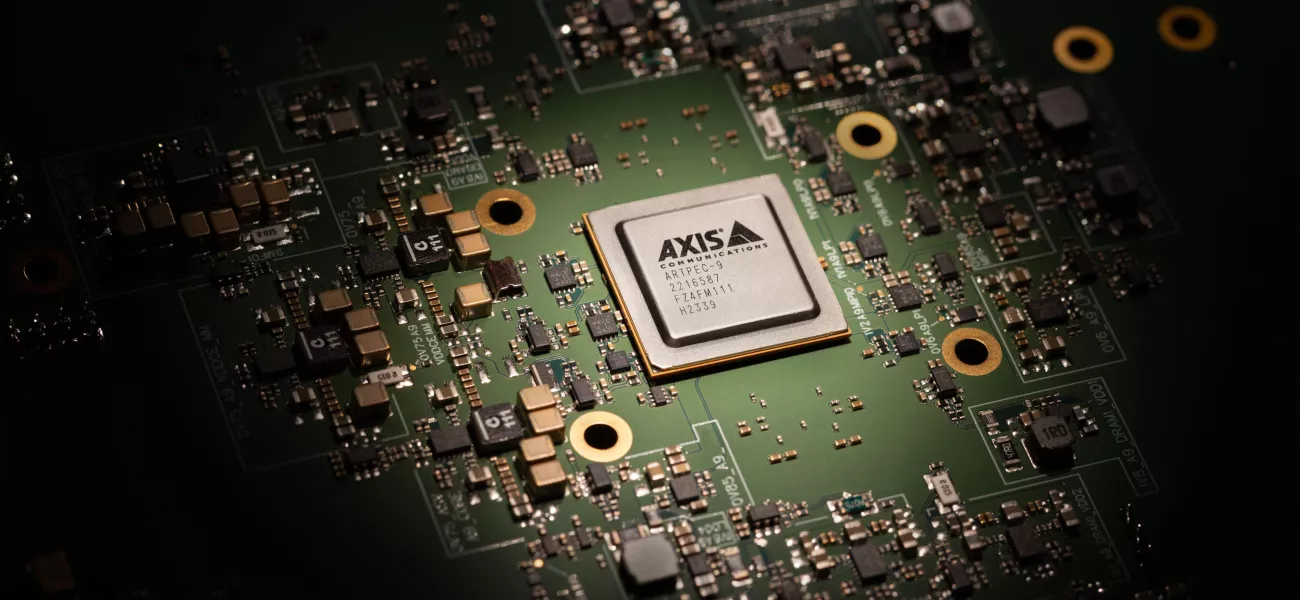
Kunden erwarten die bestmögliche Videoqualität, die Technologie heute bieten kann. Um dies zu erreichen, ist es nicht nur entscheidend, möglichst viele Teile des gesamten Produktionsprozesses selbst zu kontrollieren, sondern auch von großem Vorteil, den grundlegendsten Bestandteil der Kamera selbst zu entwickeln: das System-on-Chip (SoC).
Das ARTPEC SoC – erstmals 1999 in Produkten eingeführt und inzwischen in der neunten Generation verfügbar – bildet die Grundlage, mit der Axis die höchstmögliche Qualität bei Netzwerkkameras liefert. Speziell für Videoanwendungen mit Fokus auf Leistung entwickelt, verfeinert das aktuelle ARTPEC-9 SoC die herausragenden Fähigkeiten früherer Generationen: niedrige Bitrate, KI-gestützte Analysen, überlegene Bildqualität und integrierte Cybersicherheit. Zudem führt es AV1 ein, einen Open-Source-Standard für Videokodierung der Alliance for Open Media. Die Unterstützung von AV1 und verbesserte Bildverarbeitung ermöglichen Videos mit kompromissloser Detailtreue und Klarheit sowie erstklassiger Bitrate. Die Kontrolle über Design und Fertigung des eigenen SoC erlaubt Axis, Produkte optimal auf Kundenbedürfnisse abzustimmen und gleichzeitig externe Faktoren wie Bedrohungen der Cybersicherheit zu berücksichtigen.
Qualität aus eigener Entwicklung
Das Konzept von hoher Qualität bei Netzwerkkameras zeigt sich in vielen Facetten. Hochauflösende Bilder sind selbstverständlich, doch ebenso wichtig ist eine benutzerfreundliche Funktionalität, die den spezifischen Anforderungen jedes Kunden gerecht wird. Zunehmend gewinnt auch die Fähigkeit, Analyseanwendungen – einschließlich KI-basierter Anwendungen am Netzwerkrand – zu unterstützen, an Bedeutung. Im Zentrum dieser Qualitätsmerkmale steht das ARTPEC SoC.
Das Ergebnis von über zwei Jahrzehnten Entwicklung ist ein SoC, das dank mehrerer Faktoren einzigartig am Markt ist. Einer der wichtigsten: Das ARTPEC SoC wird vollständig im eigenen Haus spezifiziert und entwickelt. Auf den ersten Blick mag dies unbedeutend erscheinen, tatsächlich bildet es jedoch die Grundlage für zahlreiche Vorteile, die das ARTPEC SoC den Kunden bietet.
Stefan Lundberg, Senior Expert Engineer bei Axis, erklärt: „Das ARTPEC SoC war stets für effiziente Bildverarbeitung und Bildkompression optimiert – oder anders gesagt: um die Anforderungen des hochwertigen Netzwerkvideos von morgen zu erfüllen. Es ermöglicht uns, Netzwerkkameras bereitzustellen, die nicht nur Videos mit höchster Bildnutzbarkeit liefern, sondern auch hohe Leistung, gute Bandbreiteneffizienz und die Fähigkeit, KI-gestützte Analysen am Netzwerkrand auszuführen. Und dank der Eigenentwicklung können wir das SoC exakt an unsere Kamerafunktionen und damit an die Bedürfnisse unserer Kunden anpassen.“

Sicherheit im Fokus
Da Cybersicherheit ein zunehmend wichtiger Aspekt IP-verbundener Kameras und eine zentrale Kundenanforderung ist, werden ARTPEC SoCs mit Blick auf aktuelle und zukünftige Bedrohungen entwickelt. Die Kontrolle über Design und Fertigung des SoC erlaubt schnelle Anpassungen und optimierte Architektur im Hinblick auf die sich wandelnde Sicherheitslandschaft.
Die neueste Generation, ARTPEC-9, baut auf den Sicherheitsfunktionen auf, die bereits mit ARTPEC-7 eingeführt wurden: signierte Software, die nur autorisierte Programme zulässt, sowie Secure Boot, das das Starten nicht autorisierter Software verhindert. Alle neuen Geräte verfügen zudem über Axis Edge Vault zur sicheren Speicherung kryptografischer Schlüssel und Zertifikate sowie über ein Trusted Platform Module (TPM) für FIPS-konforme sichere Speicherung.

KI am Netzwerkrand und zusätzliche Sicherheitsvorteile
Ein weiterer bedeutender Vorteil, erstmals mit ARTPEC-8 eingeführt, ist die Unterstützung leistungsstarker KI-Analysen direkt am Netzwerkrand. Kameras besitzen damit die Rechenleistung, Daten unmittelbar auf dem Gerät zu analysieren. Ein Hauptnutzen ist die hochpräzise Echtzeit-Erkennung und Klassifizierung von Objekten – etwa Personen oder Fahrzeugtypen. Diese Anwendungen können direkt im Gerät eingebettet werden, sodass Videos analysiert werden, ohne Daten an einen zentralen Server zu senden. Dies bringt einen zusätzlichen Sicherheitsvorteil: Daten werden bereits am Netzwerkrand anonymisiert und verschlüsselt, bevor sie ins Rechenzentrum übertragen werden – das Risiko sensibler Datenverluste sinkt erheblich.
Blick in die Zukunft
Um den sich wandelnden Kundenbedürfnissen gerecht zu werden und Innovationen voranzutreiben, entwickeln wir unsere ARTPEC SoCs kontinuierlich weiter. Unser Expertenteam entwirft die nächste Generation, um die Anforderungen von morgen zu erfüllen.
Stefan Lundberg fasst zusammen: „Die Kontrolle, die uns das Design eigener SoCs über jeden Aspekt unserer Produkte gibt, ist aus unserer Sicht unschätzbar. Wir sind entschlossen, unsere SoCs im eigenen Haus zu entwickeln, weil es uns vor allem ermöglicht, optimierte Lösungen für Netzwerkvideoanwendungen zu schaffen. Das ist letztlich der Hauptgrund, warum Kunden und Partner Axis-Kameras wählen. Darüber hinaus gibt es weitere Vorteile – von Sicherheit durch Design bis zu geringeren Gesamtkosten. Ich bin sicher, wir werden noch viele Generationen des ARTPEC SoC in den kommenden Jahrzehnten sehen.“